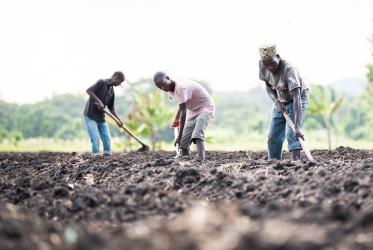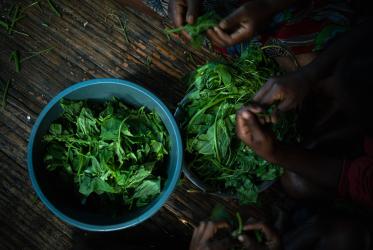*By Manoj Kurian
A publication entitled “When Food Becomes Immaterial: Confronting the Digital Age” is now available to help people explore the impact of technologies on what and how we eat, as well as on how food is produced.
During the Churches Week of Action on Food, the World Council of Churches, as part of the Global Network for the Right to Food and Nutrition, released the Right to Food and Nutrition Watch publication.
The book reflects how the technological revolution we have witnessed in the recent years has generated tremendous economic and social changes. Today, for example, an app on your smartphone can help raise awareness of a social cause worldwide and help a farmer activate the sprinklers to water her harvest in a remote area.
Yet, not every change has brought advantages. The publication highlights, with examples from different countries, how the dominant use of technologies is being increasingly used to control food and the means necessary to obtain it. The combined impact of liberalization, deregulation and privatization is increasingly extending the tentacles of tradable goods and services into domains that have been inherently public- water, education and health.
Public goods, the cornerstone of realizing human rights, are being transformed into commodities. Food – a key component of life, identity and social relations – is also being transformed into an immaterial commodity, and a source of data, which is opening a Pandora’s box of profit for corporations and the mega rich. This, in return, is affecting rural communities by further taking away their resources, damaging the environment and changing our diets for the worse.
The inequality gap between the richest and those living in utmost poverty has widened, with eight men possessing the same wealth as half of humanity. Hunger and malnutrition rates have been increasing for the last three years from 784 million in 2015 to 821 in 2017. Meanwhile, food systems are increasingly being captured by the big business, which now increasingly dictates what and how we eat.
The actors that promoted the agro-industrial model now recognize its failure but claim to have found an “innovative solution”, under the umbrella of the so-called Fourth Industrial Revolution. This is entailing a fusion of technologies that is blurring the lines between the physical, digital, and biological spheres. Within this context, three intertwined dynamics, are marking our era: dematerialization, digitalization and financialization.
The dematerialization of food is promoting the decrease of the physical substance of food and the increase of the market value of its immaterial dimensions. The latter is becoming larger than the actual value of food, from the cost of advertising, financial remunerations to investors, skyrocketing profits of large distribution channels and sophisticated attempts to use food purchases to gather information on consumers.
The digitalization of food leads to an increasingly automated, delocalized and informatized process of production and commercialization of food. This starts at the level of agricultural inputs, with seeds and other plant genetic material being transformed into digitalized sets of information, while peasants are increasingly criminalized for their exchange. This also applies to people referred to as “consumers”, which are now subjects of data-gathering mechanisms by food corporations that employ algorithms to categorize them and generate personalized offers for food they eat. The criteria that applies has little to do with preventing obesity and diabetes and other diet-related diseases, but rather with making profit and controlling people’s diets.
The financialization of food comes as a result of the dominant role played by the financial markets in determining which foods are produced, and how they are produced. It manifests itself through speculation on financial products that are linked to food, such as soya beans, or capital venture investment in farming, food production, the food industry, and food logistics. This also drives the transformation of agricultural resources, such as land, into financial assets that can be the subject of acquisitions and re-sales for profit in international financial centers. Local and rural communities, however, find themselves dispossessed from these resources with no consultation.
Technologies are not detrimental to the right to food. These have all the chances to contribute to decreasing hunger and malnutrition rates. The problem lies with how these are used and for which purpose. The current use of technologies is being driven by vested interests, often by large corporations, whose primary and sole objective is profit. Meanwhile, people whose human rights are most at risk, simply have no say in or access to these technologies.
Faith communities, social movements and human rights advocates need to further integrate the issue of technologies within their discussions. They also need to find ways to democratize the access of technologies, as well as lead the creation of new technologies that significantly contribute to justice and equity.
*Manoj Kurian is coordinator of the WCC-EAA and the Food for Life Campaign.
Right to Food and Nutrition Watch is an annual publication (from 2008) that monitors key policies, processes and issues related to the right to adequate food and nutrition at the global, regional, national and local level. The publication is the flagship of the Global Network for the Right to Food and Nutrition, which comprises 40 networks and organization with includes many faith-based networks including the WCC-EAA.
It is published by FIAN International and Brot für die Welt, with the financial support of Brot für die Welt, HEKS/EPER (Swiss Church Aid), European Commission, FIAN International , MISEREOR and Swiss Agency for Development and Cooperation.
Publication "When Food Becomes Immaterial: Confronting the Digital Age"
Photos from the opening event and discussion
WCC Ecumenical Advocacy Alliance (EAA) Food For Life Campaign






